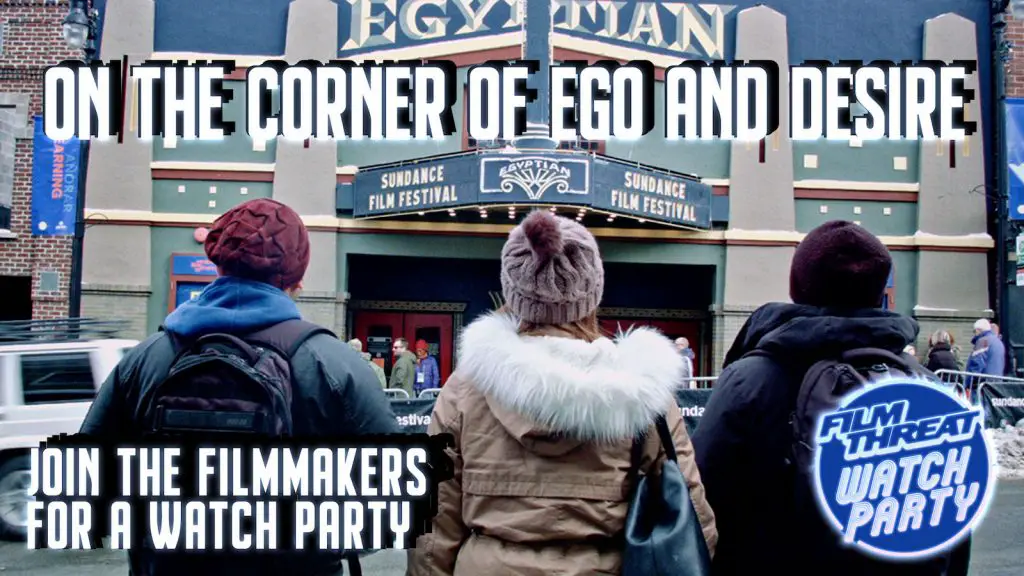
Most of this deceptively simple video consists of shots of the filmmaker, in a workout outfit, watching Jane Fonda’s workout videotape in a variety of settings while doing all of the exercises. The soundtrack is from the Fonda tape. In his pointedly narcissistic absorption in his own fitness, Stark plays a character who ignores his varied surroundings: workers, shoppers, baseball players, adults engaged in a t’ai chi class. In his bedroom, Stark ignores a large poster of Malcolm X on the wall behind him. On his balcony, he is oblivious to the fact that it is pouring rain. Meanwhile, excerpts from Fonda’s writing are superimposed on top of the footage. The writing includes her analysis of the Vietnam War and the need for revolution, as well as highly personal accounts of her life and her gradual awakening as a feminist and radical.
This simple scheme of text over images just about perfectly embodies the mind-blowing contradictions of the baby boomer generation. It makes sense that the subtitle is “Remaking Jane Fonda” because the baby boomers seem to be more obsessed with the freedom to endlessly remake themselves than with anything else. (Yippies morphing into Yuppies.) The written text reveals Fonda’s blistering intelligence, as well as her unmatched narcissism and capacity for self-deception. I can easily imagine how she mentally reconciles her stances as defiant revolutionary and purveyor of pop exercise videos: by telling herself that all of her work and fame, whether in films or in workout videos, gives her a platform and a means by which to effect social and political change. Another rationale she undoubtedly created for herself is the idea that exercise is an empowering experience which helps people on a spiritual as well as a physical level. (I seem to remember that she herself suffered a heart attack at a very young age as a result of the fact that her exercises were, in fact, harmful.)
Fonda’s workout video changed our relationship to TV in an ambiguous way: it made a watching experience which was much more physically engaged and physically active than before. But also much more focused on one’s own personal development; completely oblivious to the world around us and devoid of thought. Stark is seen performing every movement exactly as he is told to, which juxtaposes nicely with Fonda’s description of soldiers as “slaves of the rich.”
On the other hand, Fonda’s recounting of the amazing transformations which she, like so many others, experienced through feminism is truly striking. Her analysis of the war is pretty succinct and clear, I find. (Not quite as good as Noam Chomsky, but at least she understands the basic point, missed by so many Americans, that the war was in fact an invasion of South Vietnam, not a “defense.”)
The video ends by slowly zooming in on distant parts of the landscape which were previously in the background, the very parts of the landscape which Stark was oblivious to in his video exercise trance. An effective ending, these shots embody all of Fonda’s contradictions by focusing on a billboard with an Apple computer ad featuring John and Yoko, or Fonda as Barbarella, juxtaposed with Malcolm X. The video’s denouement also contains a witty allusion to Michael Snow’s “Wavelength.”
Stark followed up this piece with a 7 minute “Epilogue,” in which we see images of a jogger’s feet (the jogger holds the camera, pointing down) traversing a series of sidewalks and roads. A text crawl across the bottom of the screen contains excerpts from a Saturday Review column by Goodman Ace from 1971, in which he heaps invective on Fonda in a way that he probably thought was witty at the time, but now reads like a particularly pathetic example of a male chauvinist pig, cowering in terror at the spectacle of a brilliant, liberated woman.
This epilogue brought back to me the full force with which Fonda was hated, positively detested by so many as “Hanoi Jane.” I had forgotten the incredible intensity of those feelings, which are similar to the current conservative vendetta against Senator Clinton. (That the conservative Clinton now arouses as much hatred as the radical Fonda once did is a striking indication of how far to the right our culture has been relocated.) As Fonda explains in her memoir, quoted in the first video, she accepted all of this antagonism not because she particularly got off on being an outsider, but it was just the price she had to pay in order to grow, to remake herself. The image of feet running in the rain is an image of flight, but also of a kind of fitness routine which involves interacting with the real world, as opposed to the tv-fitness-trance routine of the first film in which the real world is ignored. Taken together, these two pieces create a powerful meditation on the contradictions which shaped a generation.
